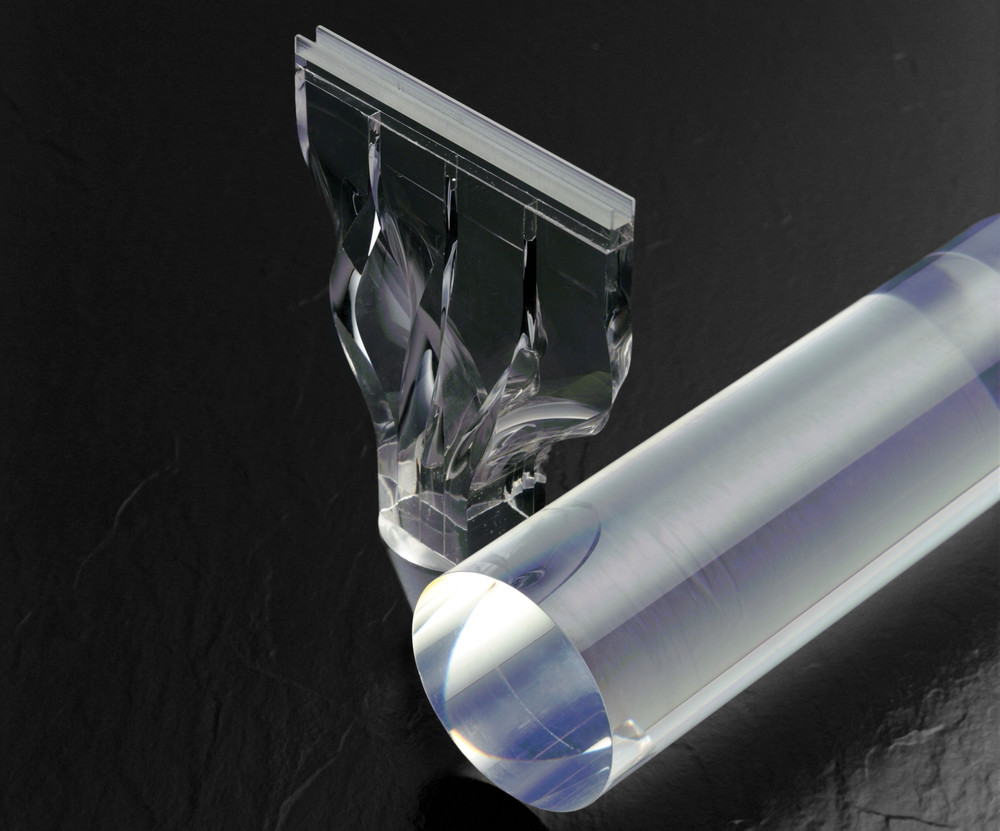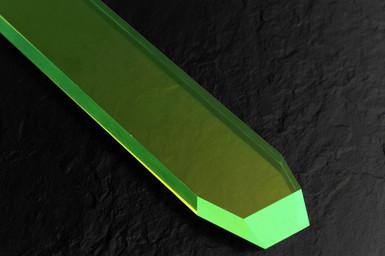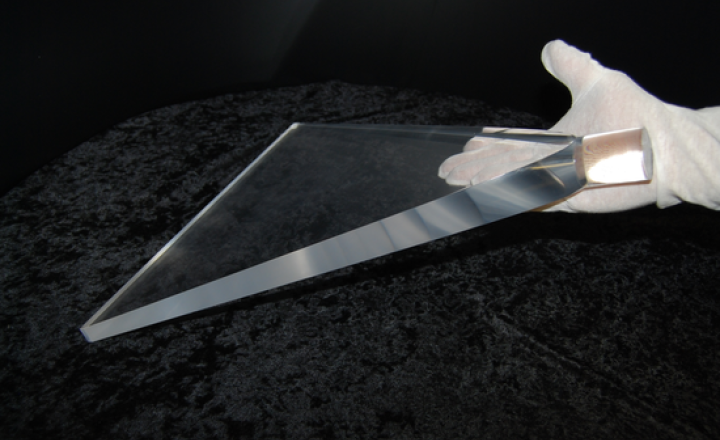BC-800, BC-802 Acrylic Plastic
BC-800 UV Transmitting acrylic plastic is the recommended light material for scintillators having emission spectra in the near UV. These include NaI(Tl) and BC-418, BC-420 and BC-422 plastic scintillators. BC-800 is also useful as a radiator for Cerenkov radiation
BC-802 UV absorbing acrylic plastic is general-purpose, non-UVT, PMMA plastic for most scintillators and is the recommended light guide material for scintillators having emission spectra in the “blue” i.e. 420 nm.
Plastic light pipes often are used with plastic and liquid organic scintillators to provide a PMT mounting surface
- Guide the scintillating light to the photocathode
- Back-off the PMT where the scintillator is in a strong magnetic field
- Minimize pulse height variation

Available in cast sheets and rods having size tolerances typical of commercial acrylic products.
Typical light guide geometries include:
- Right Cylinders are used when the light pipe diameter is the same as the scintillator diameter
- Tapered Cones are transition pieces between square-to-round or round-to-round cross-sections
- "Fish-Tail" are transition pieces from thin, rectangular cross-sections to round cross-sections
- Adiabatic provide the most uniform light transmission from the scintillator exit end to the PMT; the cross-section areas of the input and PMT faces are equal. These are typically best on wide scintillators and are the most expensive.
All light guides are custom designed to suit the particular scintillator geometry and experimental constraints. We recommend that, for scintillators <6 mm thick, a fish tail light pipe have a groove machined into its edge which joins the scintillator. The scintillator edge fits into the groove to improve the mechanical strength of the joint. Also, a disk that matches the diameter of the PMT is coupled to the light pipe’s other end to act as the PMT mounting surface.
The length of a fish tail or adiabatic light pipe is generally equal to the width of the scintillator, for scintillators 15.2 cm wide or greater.
| BC-800 BC-802 General Technical Data | |
|---|---|
| Density [g/cc] | 1.19 |
| Transmittance of Wavelength* | <370nm (at 2.54cm thick acrylic) |
| Coefficient of Thermal Expansion | 7.4X10-5/°C |
| Refractive index | 1.49 |
| Softening Point | 96°C |
| *Applies only to BC-800 | |
BC-480, BC-482A, BC-484 Wavelength Shifter Bars
WLS characteristic makes them useful as light collecting elements (similar in function to light pipes) in calorimeter detectors. Their use reduces the overall size and complexity of the detector.
Often used with scintillator shower stacks, single WLS bars are air-coupled to a stack or plane of scintillator strips. Light from the scintillators is absorbed and re-emitted by the wavelength shifter material. The scintillation light is essentially turned 90° in a very compact structure. However, there is a typical 75% loss of signal amplitude in such a system.

We make wavelength shifter bars from PMMA- and PVT-based materials. These include:
- BC-480 Blue-emitting shifts from near UV (300-360 nm) to 425 nm
- BC-482A Green-emitting shifts from 420 to 500 nm, for use with BC-408 and BC-412 plastic scintillators
- BC-484 Green-emitting shifts from 380 to 435 nm, for use with BC-414 plastic scintillator
We also supply WLS optical fibers
BC480 provides a significant improvement over standard UVT acrylic as a Cerenkov radiating medium for the following reasons:
- The more intense Cerenkov light produced at shorter wavelengths is absorbed and re-emitted in the 425nm spectral region. This corresponds to the sensitive region of most standard glass photomultiplier tubes. In addition, the light transmission is greatly improved as plastics absorb the shorter wavelength light much more strongly. Minimum Detectable Cerenkov Wavelength, 260 nm
- The Cerenkov light emitting by BC-480 is isotropic rather than directional. This permits more efficient light collection with the use of internal reflection and the light piping techniques used for plastic scintillators.
Supplied as cast sheets, rough cut or diamond milled or polished rods
Various standard cast sizes:
- 0.5 - 1 mm thick 30 x 60 cm (0.020 – 0.040” thick 11.81” x 23.62”)
- 1.5 mm thick 30 x 101 cm (0.059” thick 11.81” x 39.76”)
- 2 mm thick 45 x 101 cm (0.078” thick 17.72” x 39.76”)
- 3 mm thick 63 x 101 cm (0.118” thick 24.8” x 39.76”)
- 5, 6.4, 10, 12.7, 20, 25, 38 and 50 mm thick 63 x 203 cm
- (0.197”, 0.25”, 3.937”, 0.5”, 0.787”, 0.984”, 1.496”, 1.968” thick 24.8” X 79.92”)
- 75, 100, 125, 150 mm thick 60 x 101 cm (2.953”, 3.937”, 4.921”, 5.906” thick 23.62” x 39.76”)
| BC-480 | BC-482A | BC-484 | Shared General Tech Date | ||
|---|---|---|---|---|---|
| Scintillation Properties | Blue | Green | Blue | Base | Polyvinyltoluene |
| Decay Time (ns) | 2.1 | 12 | 3 | Density (g/cc) | 1.03 |
| Light Attenuation Length, cm | 400 | 350 | Softening Point | 70ºC | |
| Absorption Peak, nm | 420 | 375 | Refractive index | 1.58 | |
| Wavelength of Max Emission, nm | 425 | 494 | 430 | Expansion Coefficient (perºC,<67ºC) | ~7.8X10-5 |
| Minimum Detectable Cerenkov Wavelength, nm | 260 | ||||
| Pulse Width, FWHM, ns | 5 | ||||
| Solubility | Soluble in aromatic solvents, chlorinated solvents, acetone, etc. Unaffected by water, dilute acids, lower alcohols, alkalis and pure silicone fluids or grease. | ||||


